
University of Queensland’s archaeology students are able to dig up the ancient past and investigate contemporary murder scenes, thanks to a $340,000 purpose-built outdoor teaching area.
The St Lucia campus Archaeology Teaching and Research Centre (ATARC) was designed by archaeologists from UQ’s School of Social Science and opened in early March.
Archaeology lecturer Dr Pat Faulkner said the centre was the largest facility of its kind in Australia and one of the best dedicated archaeological practical learning spaces in the world.
“The 1100 metre outdoor training area features a simulated archaeological site, a replica crime scene, two areas for excavation by the public during open days, fire-fueled kilns, a smelter, forge and stone knapping areas, a projectile firing range and other experimental areas,” Dr Faulkner said.
“With a unique focus on Australia, the larger ‘dig’ area comprises a bricked-in excavation box filled with different layers and artifacts broadly representing the key periods of human settlement in the continent.”
Dr Faulkner said this allowed students to learn contemporary archaeological excavation methods and develop a deeper understanding of the human story of Australia from 50,000 years ago to the historical period.
“The complex is based on its predecessor, the Teaching Archaeological Research Discipline in Simulation facility, which was built in 1996 by Associate Professor Jay Hall (now retired) in lieu of taking students into the field to learn archaeological excavation techniques,” Dr Faulkner said.
“While the original centre included layers representing historical Mayan Classic, Bronze Age, European Neolithic and Mesolithic, and African Palaeolithic periods, the structure of the centre reflects changes in research focus within the archaeology program since the early-2000s.
“We now focus on Australia’s past.
“What we aimed for, coming off the back of the original centre, was to make the experience as realistic as possible.”
Archaeology lecturer Dr Tiina Manne, who uses the space for her course Forensics: The Archaeology of Death and Crime Scenes said the centre was an important teaching tool for students studying archaeology at UQ.
“My course involves educating students on the systematic location and recovery of human remains and other crime scene materials," Dr Manne said.
"The centre allows them to gain hands-on experience in search techniques, excavation and recovery, and analysis and conservation of material evidence that are vital in criminal investigations.”
The complex provides an archaeological teaching and research facility that ensures student training meets disciplinary and industry demands. It is regularly used by school groups learning about humanity’s past through a focus on world archaeology.
The complex was designed by UQ archaeologists Dr Andrew Fairbairn, Associate Professor Chris Clarkson, Dr Pat Faulkner and Dr Jon Prangnell, with Kim McGrath (Construction Project Manager, UQ’s Property & Facilities Division) and arkLAB Architecture.
Media: Dr Pat Faulkner, +61 7 3365 1070, p.faulkner@uq.edu.au.




